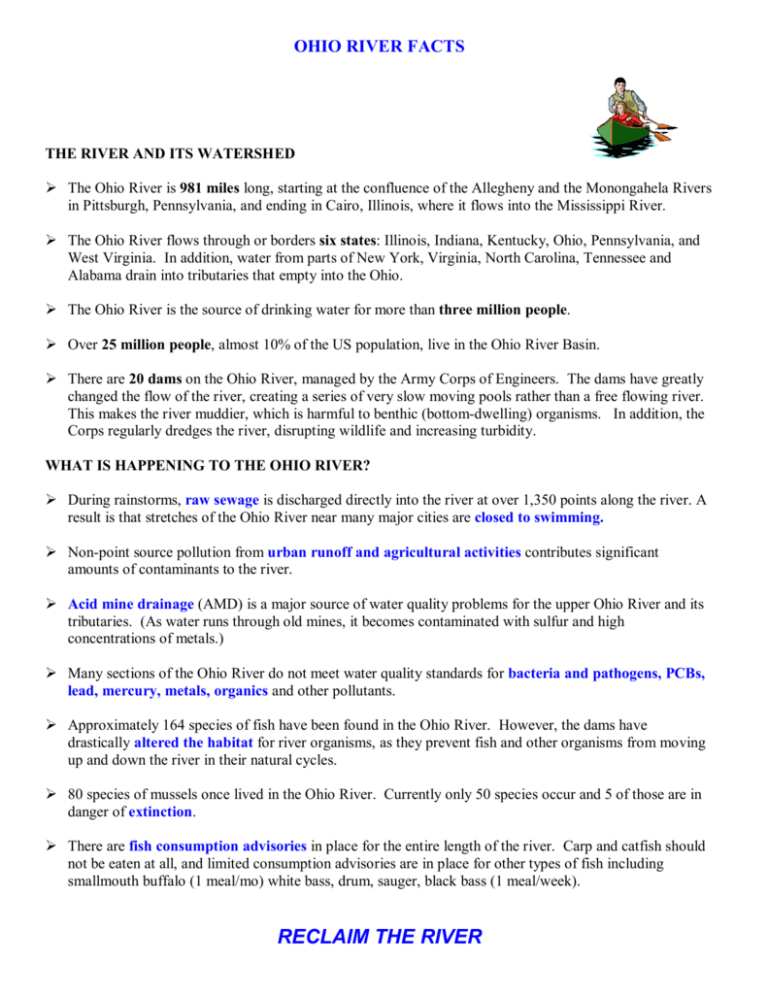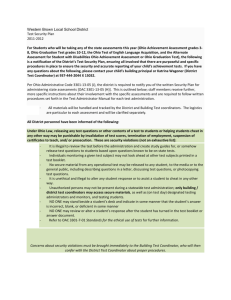Ohio River Fact Sheet - Ohio River Foundation
advertisement

OHIO RIVER FACTS THE RIVER AND ITS WATERSHED Ø The Ohio River is 981 miles long, starting at the confluence of the Allegheny and the Monongahela Rivers in Pittsburgh, Pennsylvania, and ending in Cairo, Illinois, where it flows into the Mississippi River. Ø The Ohio River flows through or borders six states: Illinois, Indiana, Kentucky, Ohio, Pennsylvania, and West Virginia. In addition, water from parts of New York, Virginia, North Carolina, Tennessee and Alabama drain into tributaries that empty into the Ohio. Ø The Ohio River is the source of drinking water for more than three million people. Ø Over 25 million people, almost 10% of the US population, live in the Ohio River Basin. Ø There are 20 dams on the Ohio River, managed by the Army Corps of Engineers. The dams have greatly changed the flow of the river, creating a series of very slow moving pools rather than a free flowing river. This makes the river muddier, which is harmful to benthic (bottom­dwelling) organisms. In addition, the Corps regularly dredges the river, disrupting wildlife and increasing turbidity. WHAT IS HAPPENING TO THE OHIO RIVER? Ø During rainstorms, raw sewage is discharged directly into the river at over 1,350 points along the river. A result is that stretches of the Ohio River near many major cities are closed to swimming. Ø Non­point source pollution from urban runoff and agricultural activities contributes significant amounts of contaminants to the river. Ø Acid mine drainage (AMD) is a major source of water quality problems for the upper Ohio River and its tributaries. (As water runs through old mines, it becomes contaminated with sulfur and high concentrations of metals.) Ø Many sections of the Ohio River do not meet water quality standards for bacteria and pathogens, PCBs, lead, mercury, metals, organics and other pollutants. Ø Approximately 164 species of fish have been found in the Ohio River. However, the dams have drastically altered the habitat for river organisms, as they prevent fish and other organisms from moving up and down the river in their natural cycles. Ø 80 species of mussels once lived in the Ohio River. Currently only 50 species occur and 5 of those are in danger of extinction. Ø There are fish consumption advisories in place for the entire length of the river. Carp and catfish should not be eaten at all, and limited consumption advisories are in place for other types of fish including smallmouth buffalo (1 meal/mo) white bass, drum, sauger, black bass (1 meal/week). RECLAIM THE RIVER







